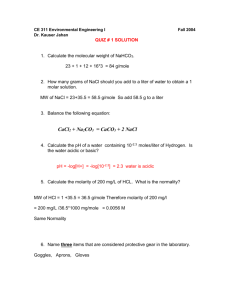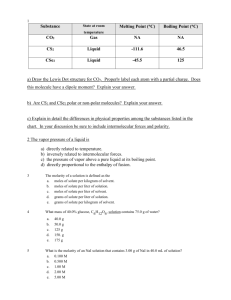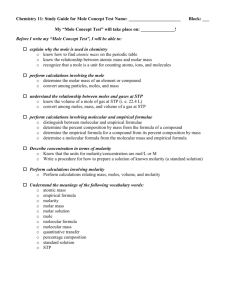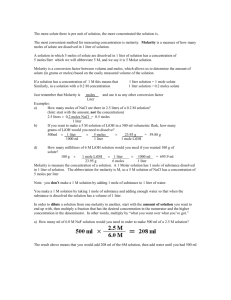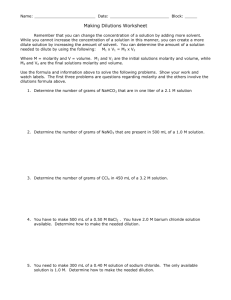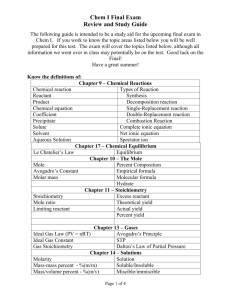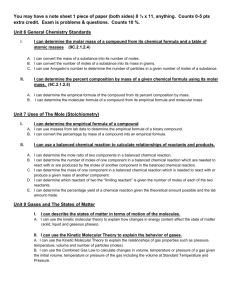Making Solutions Excerpt from Chapter 4
advertisement
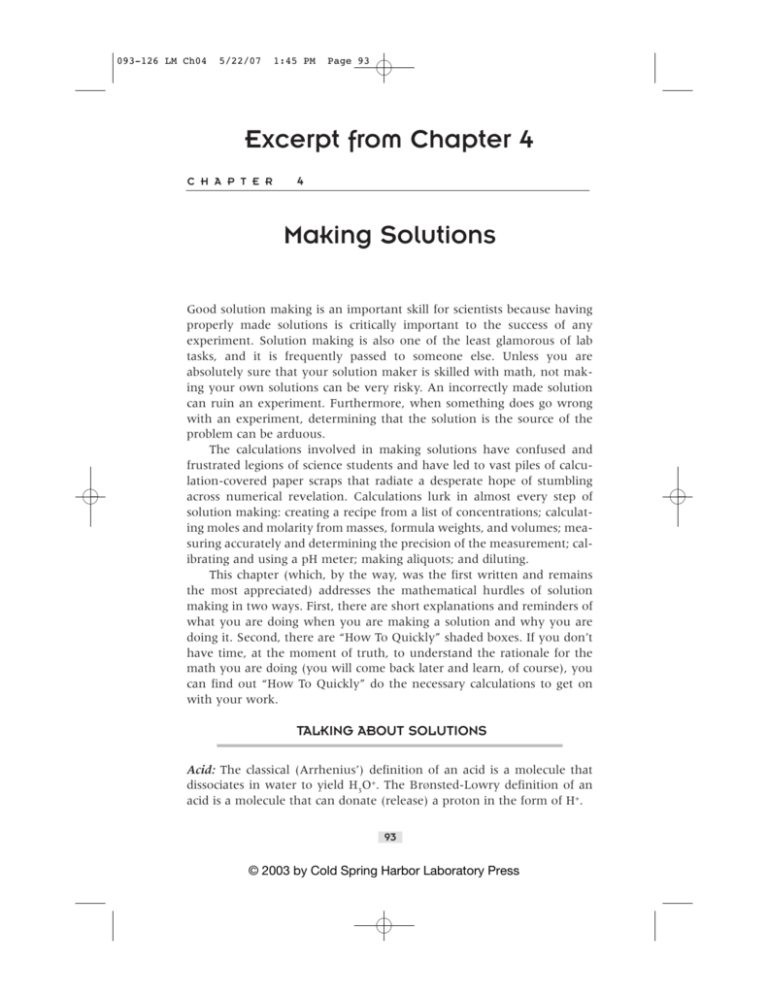
093-126 LM Ch04 5/22/07 1:45 PM Page 93 Excerpt from Chapter 4 C H A P T E R 4 Making Solutions Good solution making is an important skill for scientists because having properly made solutions is critically important to the success of any experiment. Solution making is also one of the least glamorous of lab tasks, and it is frequently passed to someone else. Unless you are absolutely sure that your solution maker is skilled with math, not making your own solutions can be very risky. An incorrectly made solution can ruin an experiment. Furthermore, when something does go wrong with an experiment, determining that the solution is the source of the problem can be arduous. The calculations involved in making solutions have confused and frustrated legions of science students and have led to vast piles of calculation-covered paper scraps that radiate a desperate hope of stumbling across numerical revelation. Calculations lurk in almost every step of solution making: creating a recipe from a list of concentrations; calculating moles and molarity from masses, formula weights, and volumes; measuring accurately and determining the precision of the measurement; calibrating and using a pH meter; making aliquots; and diluting. This chapter (which, by the way, was the first written and remains the most appreciated) addresses the mathematical hurdles of solution making in two ways. First, there are short explanations and reminders of what you are doing when you are making a solution and why you are doing it. Second, there are “How To Quickly” shaded boxes. If you don’t have time, at the moment of truth, to understand the rationale for the math you are doing (you will come back later and learn, of course), you can find out “How To Quickly” do the necessary calculations to get on with your work. TALKING ABOUT SOLUTIONS Acid: The classical (Arrhenius’) definition of an acid is a molecule that dissociates in water to yield H3O+. The BrØnsted-Lowry definition of an acid is a molecule that can donate (release) a proton in the form of H+. 93 © 2003 by Cold Spring Harbor Laboratory Press 093-126 LM Ch04 94 5/22/07 1:45 PM Page 94 Chapter 4 Base: The classical (Arrhenius’) definition of a base is a molecule that dissociates in water to yield OH–. The BrØnsted-Lowry definition of a base is a molecule that can accept a proton in the form of a hydrogen atom (H+). Acid Dissociation Constant, Ka: The equilibrium constant of an acid. Ka = + – _______________ [H] [OH ] [H2O] If Ka > 1, it means the acid is strong, i.e., likely to readily donate a proton. If Ka < 1, it means the acid is weak, i.e., less likely to donate a proton. Buffer: A buffer is a weak acid that is added to a solution to prevent changes in the pH when a small amount of a strong acid or base is added. Buffers work by accommodating the added acid or base with changes in the relative concentrations of the weak acid and its conjugate base (i.e., the concentration of buffer molecules that can donate protons and the concentration that can accept protons). cc: cc stands for cubic centimeter. One cc equals one milliliter. Diluent: The diluent is the medium or solvent added to a concentrated solution in order to dilute it. Diluting 1:X: Recipes for solutions sometimes contain directions for diluting a stock solution according to a certain ratio. To read those directions, you need to know the following. A 1:X dilution means your concentrated solution should be diluted to 1/Xth its current concentration. Add 1 volume of concentrate to (X – 1) volumes of diluent to create a total volume equal to X. Looking at it yet another way, in the final solution what you diluted will be 1/Xth of the total volume. Therefore: 1:100 1:14 1:2 1:1 means means means means 1 part concentrate, 99 parts diluent 1 part concentrate, 13 parts diluent 1 part concentrate, 1 part diluent straight concentrate Note: This is the original convention; however, it is not always followed. If you see 1:9, chances are the author means 1:10 and the recipe should be checked. This is particularly true if you see dilute 1:1 in a recipe; chances are the author means 1:2. You have to use your judgment. This confusion is one reason why it is always better to report starting and final concentrations explicitly. λ: λ is an abbreviation for microliter (μl) and the symbol for wavelength. The context around the use of λ indicates which meaning is applicable to the situation. © 2003 by Cold Spring Harbor Laboratory Press 093-126 LM Ch04 5/22/07 1:45 PM Page 95 Making Solutions 95 Medium: A solution. The plural is media. In biology, the word “medium” is typically reserved for solutions made specifically to feed cells. Meniscus: The surface of the liquid in a thin cylindrical container is concave, and the rounded surface is called the meniscus. Glassware is calibrated so that the correct volume is measured when the bottom of the concave meniscus lines up with the volume marking. Molarity: The molarity of a solution is the moles of solute per liter of solvent. Molarity is an SI unit and the symbol is M. If there is more than one component in a solution, the molarity of each is given separately. For example, a solution might be 1 M NaCl (58.43 g/mole; so the solution has 58.43 g of NaCl per liter of solution), 0.5 M CaCl2 (219.08 g/mole; so the solution has 109.54 g of CaCl2 per liter of solution). Molar: Molar is an adjective describing molarity. For example, a bottle is labeled 1 M MgCl2; the solution is “one molar magnesium chloride,” which means that the molarity of MgCl2 in the solution is one mole of MgCl2 per liter of solution. Molality: The molality of a solution is the moles of solute per kilogram of solvent. Molality is not really analogous to molarity: Not only do you substitute kilograms for liters, but molarity is moles per liter of solution, whereas molality is moles per kilogram of solvent. The symbol for the unit is a lowercase m. Mole: An amount; 6.022 x 1023 of molecules of a substance. One mole of a substance has a mass equal to its molecular weight in grams. For example, HEPES has a molecular weight of 238.3; one mole of HEPES “weighs” (has a mass of) 238.3 grams. Mole is the SI unit for amount of substance. It is abbreviated mol. Percent: Percent is a dimensionless parameter meaning per one hundred (as in per centum); 37% of A = 37/100 x A = 0.37A. Percent Volume per Volume (v/v) or Weight per Weight (w/w): The amounts of ingredients in a solution are sometimes described as a percentage of the total solution. To read those recipes, you need to know the following. If the units are the same (e.g., w/w or v/v), the percentage is what you expect based on the definition of percent: 100% = 1 g/1 g 1% = 10 ml/liter Percent Weight per Volume: This is one of those cases where “weight” really means “mass.” Percent mass per volume (abbreviated % w/v) is © 2003 by Cold Spring Harbor Laboratory Press 093-126 LM Ch04 96 5/22/07 1:45 PM Page 96 Chapter 4 based on a convention which is the mass/volume of pure water: 1 ml of water has a mass of 1 gram; hence, 1 g/ml = 100%. It works as follows: 100% = 1 g/ml 10% = 100 mg/ml 1% = 10 mg/ml If you just see % without any units such as w/v, you can assume it means w/v. pH: pH is used to quantify the acidity of a solution. The “p” indicates that you take the negative log of what follows, which is H, signifying the concentration of protons. pH is therefore a measure of the concentration of protons, or H+, in a solution. As the number of protons in solution increases, the magnitude of the pH decreases; so the lower the pH of a solution, the more acidic it is. Q.S.: Q.S. stands for “quantity sufficient” and means “add enough solvent to bring the total volume to...” For example, “Q.S. to 500 ml” means “whatever volume you have now, add the amount necessary to make the total volume 500 ml.” To Q.S. a solution properly, it must be measured in an appropriately calibrated vessel (i.e., a graduated cylinder, not a beaker). Reagent: A compound or solution that will go into your reaction mixture. Solute: The dissolved, or dispersed (as opposed to the liquid), phase of a solution—the stuff you mixed in. Solution: A homogeneous mixture (usually liquid) of two or more substances; one or more solutes dissolved in solvent. The solutes can be solid, liquid, or gas; the solvent can be liquid or gas. Solvent: The dispersing (i.e., liquid) phase of a solution. The substance into which a solute is dissolved—what you mixed stuff into. NUMBERS FOUND ON CHEMICAL BOTTLES The first thing you are likely to pick up when you begin to make a solution is a bottle of some chemical. Important numbers are found on the labels of chemical bottles and in chemical company catalog listings. Many of the numbers included on chemical bottles have obvious meanings, and others do not; but each provides information that may be extremely useful. Below is a list of numbers typically reported on chemical containers, and why you want to know them. Product Number: This is the company catalog number, and it is very useful for correct reordering, particularly when a chemical is available in © 2003 by Cold Spring Harbor Laboratory Press 093-126 LM Ch04 5/22/07 1:45 PM Page 97 Making Solutions 97 several forms. (The compound may be available in a hydrated form or at a different concentration or purity.) Lot Number: It is a good idea to record the lot number of a reagent in your lab notebook, especially when using reagents that may vary significantly from batch to batch, such as antibodies or enzymes. Having the lot number easily accessible can be very useful for troubleshooting your experiments. It may be a reagent, not you, that causes an experiment to go awry. When you call a company to ask if a batch of enzyme is known to have been contaminated or is of low activity, for example, technical support at the company will need to know the lot number. Storage Temperature: This tells you the temperature to store a reagent to avoid things like loss of activity or decay. Pay attention to the storage temperature (and expiration dates) of chemicals, because chemicals really can go bad. –70ºC –20ºC –20ºC–0ºC 0ºC 2ºC–8ºC RT means means means means means means keep keep keep keep keep keep it it it it it it in the ultracold freezer (usually –70ºC to –80ºC) in the deep freeze in the freezer compartment of the refrigerator in the freezer compartment of the refrigerator in the refrigerator at room temperature Also watch labels for notes indicating whether a chemical should be stored desiccated or in the dark. Formula Weight (FW): This tells you the mass in grams per mole of the chemical as listed in the formula on the label; in this context, FW is being used interchangeably with molecular weight. If it is a hydrated compound, the FW includes the mass of the water. For more on this topic, including FW versus MW, see Chapter 2. Purity: Sometimes trace amounts of by-products of the method used to isolate a chemical compound cannot be entirely eliminated. Purity is a measure of, well, the purity of a chemical, i.e., it tells you how much is not contamination. Purity is typically represented as a percent: The percentage of what you bought that is actually what you want. Risk and Safety Numbers: These numbers refer to lists found in the catalogs of companies that sell chemicals. They are like mini-Material Safety Data Sheets (MSDS); but the MSDS is the only reliable source for complete safety information. MSDSs are available free online at a number of sites, as listed in Resources at the end of this chapter. Activity and Unit Definition: Activity and unit in this context apply to enzymes and tell you how much activity to expect from an enzyme and © 2003 by Cold Spring Harbor Laboratory Press 093-126 LM Ch04 98 5/22/07 1:45 PM Page 98 Chapter 4 what the units of that activity mean. For example, alcohol dehydrogenase can be purchased with the activity 300–500 units per milligram protein, where 1 unit will convert 1.0 μmole of ethanol to acetaldehyde per minute at pH 8.8 at 25ºC. In this case, the activity is a rate. MOLES AND MOLARITY Moles and molarity are both units (see Chapter 1). Mole is the SI unit for the dimension of an amount of a substance (dimension N), and molarity is the SI unit for concentration, where concentration is the amount of a substance per liter of solution (dimension NL–3). So, the number of molecules of a chemical is counted in moles, and the concentration of molecules in a solution is quantified as the molarity. The word “mole” is like the word “dozen” in that it is a special name for a particular number. Dozen is a name for the quantity 12; mole is a name for the quantity 6.022 x 1023. 6.022 x 1023 goes one better than 12 in that it actually has two special names. One of the names, at the risk of being repetitive, is “mole” and the other is “Avogadro’s number” (in honor of Amedeo Avogadro, who in 1811 was the first to distinguish between atoms and molecules, and who stated that equal volumes of all gases at the same temperature and pressure contain the same number of molecules, now known as Avogadro’s principle). When you talk about moles of a chemical, you are talking about the number of smallest indivisible units of that chemical, i.e., the number of molecules of that chemical. A mole of a chemical is 6.022 x 1023 molecules, just like a dozen eggs is 12 “smallest indivisible units of eggness.” Why people talk about dozens of things is anyone’s guess, but there is a very good reason to talk about moles of chemicals: One mole of a chemical has a mass equal to the molecular weight. To figure out how many moles of a chemical you have, you measure the mass of the chemical (using a balance) and then divide that mass by the molecular weight of the chemical (which is listed as the FW on the label). The result is the number of moles you have. For example, HEPES has an FW of 238.3; one mole of HEPES weighs (has a mass of) 238.3 grams. If you weigh out 327.4 g of HEPES and want to know how many moles that is, you simply divide the amount you’ve weighed by the weight of one mole: 327.4 g ÷ 238.3 g/mole = 1.37 moles of HEPES. The molarity of a solution is the moles of solute per liter of solvent. Molarity is the SI unit of concentration, and saying “molarity” is the same as saying “moles of solute per liter of solution.” The symbol for molarity is M. Molar is an adjective describing molarity. For example, a bottle is labeled 1 M MgCl2; the solution is “one molar magnesium chloride,” © 2003 by Cold Spring Harbor Laboratory Press 093-126 LM Ch04 5/22/07 1:45 PM Page 99 Making Solutions 99 which means that there is one mole of MgCl2 per liter of solution (or one millimole of MgCl2 per milliliter of solution, or one micromole per microliter, etc.). Another way to say it is “the molarity of the solution is 1.” If there is more than one component in a solution, the molarity of each is given separately. MAKING SOLUTIONS FROM DRY CHEMICALS General Warning Sometimes recipes will say that upon completion, a solution will be of a certain pH. It is important to check that the solution has actually achieved the noted pH. Sometimes things such as the pH of the distilled water used to make solutions can vary from lab to lab; you cannot blindly count on it to be pH 7. Such factors can alter your ultimate pH. Solution making most typically involves dissolving a dry chemical into water or other specified solvent. The amount of chemical you add to a solvent depends on the final concentration (molarity) you want in the finished solution and the total amount (liters) of solution you have decid- © 2003 by Cold Spring Harbor Laboratory Press 093-126 LM Ch04 100 5/22/07 1:45 PM Page 100 Chapter 4 ed to make. The easiest way to measure chemicals, however, is by mass, since mass is what lab balances report (for more about balances, see Chapter 2). So, to make a solution, typically you have to determine the mass of chemical that you need, based on knowing the desired final concentration (usually molarity), the molecular weight of the chemical, and the final volume of solution. Here is how to do that. When making any solution, you should start by putting about 80% of the total volume of solvent into your mixing vessel and then add the chemicals one by one. Once all the chemicals have been added, transfer your almost finished solution to a graduated cylinder; then Q.S. (see page 96) to the final total volume. You do it that way because the chemical you are adding will contribute some volume to the solution and you don’t want to inadvertently overshoot the desired final total volume. Planning a Solution of a Particular Molarity METHOD One simple way to plan the making of a solution from a dry chemical is as follows: 1. Figure out the mass you would need if making a full liter. 2. Figure out what fraction of a liter you are making. 3. Use that same fraction of the mass of the chemical. 7 Example This example shows how to figure out a recipe step by step. At the end of this example is the “How to Quickly” that you can use for reference to get on quickly with making your solution. Say you want 100 ml of a 5.00 M stock solution of calcium chloride, CaCl2. The MW of CaCl2 is 111.0 grams per mole. 1. Figure out how many grams of CaCl2 would go in 1 liter by multiplying the number of moles in 1 liter times the molecular weight of the compound: 5.00 M = 5.00 moles/liter 5.00 moles x 111.0 g ___________ mole = 555.0 g 2. Figure out what fraction of 1 liter you are making by dividing the desired volume by 1 liter: 100 ml ____________ 1000 ml = 0.1 © 2003 by Cold Spring Harbor Laboratory Press 093-126 LM Ch04 5/22/07 1:45 PM Page 101 Making Solutions 101 3. Multiply the fraction of a liter times the number of grams to make 1 liter of solution of the same molarity (0.1 x 555.5 g). 0.1 x 555.0 g = 55.5 g To make 100 ml of a 5.00 M solution of CaCl2, dissolve 55.5 g into approximately 80–90 ml of water and then Q.S. to 100 ml. Written as one expression, this looks like: 5.00 moles x 110.0 g ___________ mole x –1 ______________ 10 liter liter = 55.5 g This expression can be simplified (which is always good). First, notice that the second term is the molecular weight of the chemical; so, substitute MW. Second, notice that the third term can be written as 10–1 liter x liter –1. Since multiplication is commutative, the x liter –1 can be moved over and combined with the first term; that makes the first term 5.00 moles/liter, which, you may notice, is the desired molarity, 5.00 M. So the above equation simplifies to: 5.00 M x MW x 10–1 liter = 55.5 g or, the desired molarity (mole/liter) times the molecular weight (gram/mole) times the desired volume (liter) equals the grams of chemical required. DON’T FORGET: When you are actually making up the solution, put only about 80% of the total volume of solvent into the beaker before adding the chemicals. Once the chemicals have been added and dissolved, only then should you transfer the contents to a graduated cylinder and Q.S. to the final total volume. HOW TO QUICKLY Calculate the Grams of Chemical Needed for a Solution of Particular Molarity Plug your numbers into the following equation (calculate individually for each solute): M x MW x V = g Add chemicals to 80% of volume then Q.S. to the final volume. M = Final molarity of compound [mole liter –1] MW = Molecular weight of compound (listed on the bottle as FW) [g mole –1] V = Desired final volume [liter] g = Grams of compound to add to solvent [g] Q.S. = “Add sufficient solvent to bring the volume (to the final volume)” See also Plug and Chug in Chapter 8. © 2003 by Cold Spring Harbor Laboratory Press 093-126 LM Ch04 102 5/22/07 1:45 PM Page 102 Chapter 4 MAKING SOLUTIONS FROM HYDRATED COMPOUNDS Some chemicals come with water molecules attached. The first thing to remember is that the MW (listed as FW on the bottle) of such a compound includes the mass of the water; whenever you would have used the MW of the unhydrated compound in the equations above, use, instead, the MW of the hydrated compound. If you have a recipe that tells you how many grams to use of the unhydrated compound, figure out target concentration (see “Calculating Concentrations from Recipes” below) and then calculate the grams to use of hydrated compound. The second thing to remember when using a hydrated compound is that the attached water molecules contribute water to the solution, potentially diluting the final concentrations (if the solvent is water). Therefore, you must account for the contribution of water from the hydrated compound when determining the volume of solvent (water) to add. 7 Example 1 1. You can buy sodium phosphate as NaH2PO4 • H2O (sodium phosphate monobasic, FW = 137.99). 2. If you want the molarity of the NaH2PO4 to be 0.5 M in a liter, weigh out 68.99 g (i.e., 0.5 x 137.99) and add it to your solution. Here’s the catch: for every 0.5 mole of NaH2PO4 • H2O you add to the solution, you are adding 0.5 mole of sodium phosphate and you are adding 0.5 mole of water. One mole of water takes up 18.015 ml. Just by adding 68.99 g of compound, you have added 9.008 ml of solvent; you need 991 ml (100 – 9.008) more to reach 1 liter. 7 Example 2 1. You can buy sodium phosphate hydrated with 12 waters: Na3PO4 • 12H2O (sodium phosphate tribasic, FW = 380.12). 2. If you want the molarity of Na3PO4 to be 0.5 M in a liter, weigh out 190.06 g of Na3PO4•12H2O (0.5 x 380.12) and add it to your solution. If you are using this compound, for every 0.5 mole of sodium phosphate you add, you are adding 6 moles of water, which has a volume of 108.09 ml. To Q.S. to 1 liter only requires 891.91 ml (1000 – 108.09). © 2003 by Cold Spring Harbor Laboratory Press 093-126 LM Ch04 5/22/07 1:45 PM Page 103 Making Solutions 103 The moral of these stories is that you must know in advance what volume of water will be contributed by the hydrated compound, and you must accommodate that volume. One way to accommodate the volume of water contributed by a hydrated compound is to calculate exactly what volume of water you will be adding when you add the hydrated compound, and then subtract that volume from the volume of water you planned to add. Using the second of the above examples, if you wanted 100 ml of 0.5 M Na3PO4, you could calculate that if you use the Na3PO4 • 12H2O, you will be adding 10.81 ml of water (1/10th the volume of 6 moles of H2O calculated above) along with the compound; so you will only need to add 89.19 ml (100 – 10.81) more water. The steps of that calculation are: 1. Multiply the desired molarity times the desired volume. This tells you the moles of compound you will be adding. 2. Multiply the number of moles of the compound times the number of moles of H2O in the compound. The result is the number of moles of H2O you will be adding. 3. The number of moles you are adding, times 18.015, tells you the number of milliliters of water you will be adding. 4. Subtract the number of milliliters you are adding from the total volume. HOW TO QUICKLY Calculate Water Contributed by a Hydrated Compound Plug your numbers into the following equation: M x V x #H2O x 18.015 = ml H2O contributed by hydrated compound Calculate individually for each hydrated solute. = Desired molarity of compound [mole liter –1] V = Desired final volume of solution [liter] #H2O = Number of H2O molecules in the hydrated compound 18.015 = Milliliters per mole of H2O [ml/mole] M See also Plug and Chug in Chapter 8. The calculation to figure out how much water you are adding is useful for making sure your measuring container doesn’t overflow. The easier way to deal with hydrated compounds is to follow the directions for making any solution: Start with less than the total volume of solvent, mix in the chemicals, then transfer it all to a graduated cylinder, and Q.S. to the final volume. When working with hydrated compounds, however, you have to be particularly careful how much you start with. It is a good idea to do the above calculation, and then start with 80% of what you will end up adding (rather than 80% of the total final volume). © 2003 by Cold Spring Harbor Laboratory Press 093-126 LM Ch04 104 5/22/07 1:45 PM Page 104 Chapter 4 HOW TO QUICKLY Make a Solution Using a Hydrated Compound 1. Calculate about how much water will be needed after the hydrated compounds are added using How To Quickly calculate water contributed by a hydrated compound: M x V x #H2O x 18.015 = ml H2O contributed. Subtract that many milliliters from the desired final volume (V). 2. Put 80% of the resulting volume of H2O into a mixing vessel. 3. Add your compounds. Mix well. 4. Transfer the solution-so-far to a graduated cylinder. 5. Q.S. to the desired final volume in a graduated cylinder. MAKING STOCK SOLUTIONS In many labs, or for particular experiments, certain solutions are used frequently and are therefore made up in large quantities. To minimize the volume actually occupied by these solutions, they are often made at a higher concentration than that which will be used. These concentrated solutions are referred to as stock solutions. Stock solutions save time, in addition to space, because when you need a solution stored as a concentrated stock, you need only to dilute the stock; you don’t have to start from scratch. Some commonly encountered stock solutions are: 10x TBE (in labs that run a lot of gels), 10x SSC (in labs that do lots of hybridizations), and 10x PBS (in labs that do just about anything with cells). Making a stock solution is just like making any solution; you simply scale up the concentration of all of the ingredients. Typical stock solutions are 2x, 5x, and 10x, meaning double the normal concentration, five times the normal concentration, and ten times the normal concentration. The upper limit to the concentration of a stock solution is set by the solubility of those chemicals in that solvent. It is important to be very careful not to contaminate a stock solution. If a stock solution gets contaminated, you must dispose of it immediately. If you do not, you will mess up experiments for what will feel like an eternity. To avoid contaminating a stock solution, never put anything into its container—no pipettes, nothing. Always pour some stock out into a second, clean container, and then take what you need from there. This is just being considerate to others and preventing headaches for yourself. Diluting a Stock Solution to a Particular Concentration Having concentrated stock solutions available in the lab is a great time saver if everyone who will be using them is comfortable diluting. The fol- © 2003 by Cold Spring Harbor Laboratory Press 093-126 LM Ch04 5/22/07 1:45 PM Page 105 Making Solutions 105 lowing instructions make diluting easy. The section begins with an explanation, and ends with a How To Quickly. If you know what concentration of a solution you want and need to figure out how much of a concentrated stock solution to dilute, use the following equation: © 2003 by Cold Spring Harbor Laboratory Press
